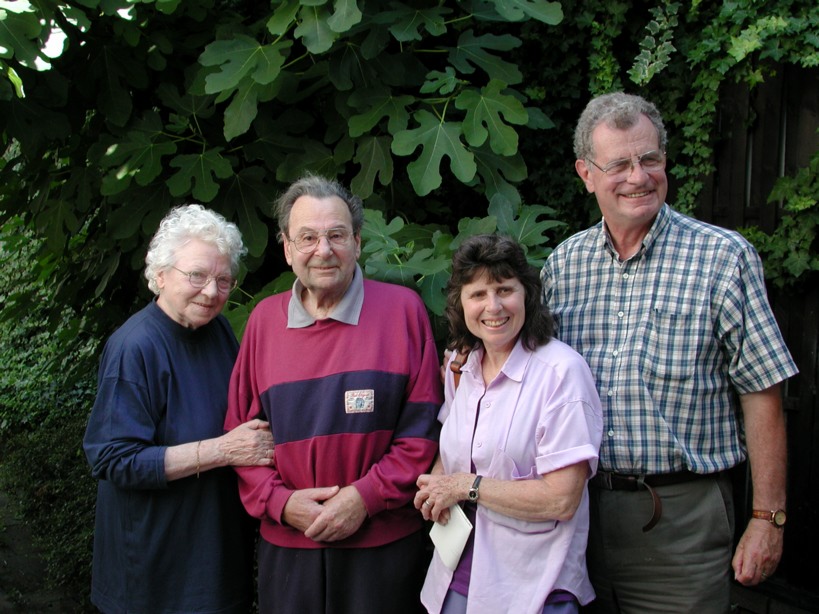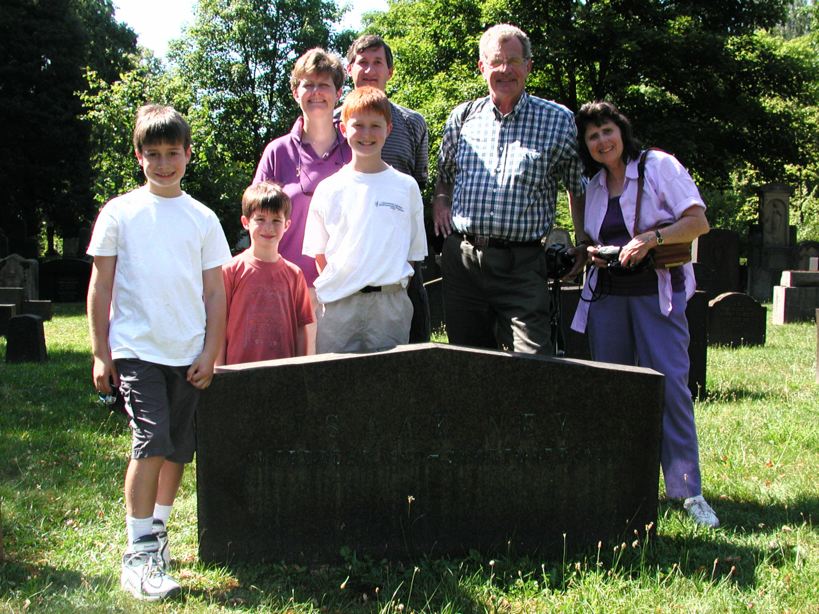
Home • Arrival • Setting Up • Loire • Paris • Chartres

Yesterday we rented the car and outfitted the apartment with new treasures from Ikea. Today’s agenda was to visit the town where Pete visited his grandfather and grandmother when he was 3, and returned to perhaps twice before he left Germany more than 60 years ago. Thanks to Lotte Jacobs, Peter’s cousin, he knew the address of the house: 12 Glockenstrasse. We set out in the red Peugeot van for the country that until very recently Pete vowed never to revisit.
There is no border crossing these days between Germany and France, thanks to the European Union, so we slid quite easily into Germany and found the town of Kaiserslautern. It has a large American military presence, and we saw plenty of housing for the American families. In fact, we saw traffic signs warning folks that they were entering civilian roadways and to drive accordingly! We followed signs through Kaiserslautern, or so we thought, but quickly found ourselves entering a neighboring town, so we turned around and headed to the train station. There Pete asked a taxi driver where Glockenstrasse was, and damned if it wasn’t the next street over, except that thanks to road construction, we had to backtrack a block or two.
 We found a parking place on Glockenstrasse, but couldn’t buy a parking pass
because we didn’t have any Deutsche Marks, so we crossed our fingers and
started walking down the street. After three blocks we saw the telltale
passageway on the left, just as Pete remembered it. Luckily, the gate was
open so we went in and started looking around. The pictures show Pete in
front of the doorway, which probably went into the old house, with stables
beyond and in the building on the right. His grandfather was a used horse
dealer, an occupation which was winding down in the early 1930s, I suppose.
We found a parking place on Glockenstrasse, but couldn’t buy a parking pass
because we didn’t have any Deutsche Marks, so we crossed our fingers and
started walking down the street. After three blocks we saw the telltale
passageway on the left, just as Pete remembered it. Luckily, the gate was
open so we went in and started looking around. The pictures show Pete in
front of the doorway, which probably went into the old house, with stables
beyond and in the building on the right. His grandfather was a used horse
dealer, an occupation which was winding down in the early 1930s, I suppose.
The main house, the corner of which can be seen at the extreme left of the first picture, has been taken over by the city to be used as a shelter for battered women. After we had been snooping around for awhile, an elderly woman and her daughter came out to inform us that this was private property, and to ask us what we were doing. We explained the story, and the daughter reassured her mother that the folks snooping around would not cause any problems. Still, we felt a bit rushed after this, and after we had left the drive way the old woman closed the gate to keep the riffraff out.
Lotte had also informed Pete of the neighbors across the street at 13 Glockenstrasse. Lotte had played with Gerta Leüthner as a girl and remains in telephone contact with her. Betty encouraged Pete to ring, and when Rudolf Leüthner poked his head out the second-story window, he explained who he was. Rudolf got his wife, who after hearing the story came down to let us into their courtyard.
 Pete and I, in halting German, carried on conversations with the sweet
couple, who kept asking me to sit down and wondering what they could fetch
us to eat or drink. He explained who we were and how he was related
to Lotte and Isaak Ney. She spoke very slowly and clearly and I was
pleased how easy it was to follow her and even to get some points across. I
guess some of the brain cells devoted to German haven’t expired since I
was last called upon to speak it. Of course, Pete’s have been lying dormant
even longer, and he was pretty happy to find that he could communicate
effectively and understand everything. Rudolf showed us his cactus garden,
which he has maintained for 40 years in a greenhouse off the courtyard. It
was about 110°F in there, reminding us an awful lot of summer weather
in Claremont. Tricky snapping a close-up in there, too, because you’re
tempted to focus on the front end as you lean over for the picture.
Pete and I, in halting German, carried on conversations with the sweet
couple, who kept asking me to sit down and wondering what they could fetch
us to eat or drink. He explained who we were and how he was related
to Lotte and Isaak Ney. She spoke very slowly and clearly and I was
pleased how easy it was to follow her and even to get some points across. I
guess some of the brain cells devoted to German haven’t expired since I
was last called upon to speak it. Of course, Pete’s have been lying dormant
even longer, and he was pretty happy to find that he could communicate
effectively and understand everything. Rudolf showed us his cactus garden,
which he has maintained for 40 years in a greenhouse off the courtyard. It
was about 110°F in there, reminding us an awful lot of summer weather
in Claremont. Tricky snapping a close-up in there, too, because you’re
tempted to focus on the front end as you lean over for the picture.
The other spot we wanted to visit was the cemetary, so we asked for directions. Gerta brought out a map and showed us how to get there. We then asked for the more urgent need, a restaurant in which to get good ol' fashioned sauerkraut. This was just a couple blocks away, so we thanked them for their hospitality and hoped that it was still open for lunch at 13:30. Unfortunately, they did not take credit cards and were closing at 14:00. The rest of us sat down and ordered while Pete and Betty set off for the post office, which was supposed to have an ATM. It took them awhile, long enough that I headed out in the opposite direction to look for another place to get cash. You know, this Euro thing is a darn good idea! Come January 1, this will no longer be a problem. Anyway, they were more successful than I and we had a fine lunch of sauerkraut and German beer, or as the locals might say, ein gute Sauerkrautunddeutschesbiermittagessen!
 Luckily, there was no ticket on the car when we had finished with lunch,
and so we hopped in and headed for the cemetary. Isaak Ney was buried
there in 1934, after which his wife moved to Frankfurt and then Berlin. We
stopped in at the office and asked whether there were records that would
indicate where in the cemetary we might find the grave. When they heard
the date of his death, they apologized and said that unless extra money
was paid, graves were reused after 25 years, so that the graves would no
longer exist. Well, we tried. Just as we were about to leave, Pete thought
to mention that he was Jewish. That's a horse of another color! The graves
in the Jewish section have not been disturbed. While they hauled out
papers showing the layout of the Jewish section, I grabbed a couple of
boys and headed out to the cemetary.
Luckily, there was no ticket on the car when we had finished with lunch,
and so we hopped in and headed for the cemetary. Isaak Ney was buried
there in 1934, after which his wife moved to Frankfurt and then Berlin. We
stopped in at the office and asked whether there were records that would
indicate where in the cemetary we might find the grave. When they heard
the date of his death, they apologized and said that unless extra money
was paid, graves were reused after 25 years, so that the graves would no
longer exist. Well, we tried. Just as we were about to leave, Pete thought
to mention that he was Jewish. That's a horse of another color! The graves
in the Jewish section have not been disturbed. While they hauled out
papers showing the layout of the Jewish section, I grabbed a couple of
boys and headed out to the cemetary.
 We managed to find Pete’s great-grandfather (Abraham Ney) and
great-grandmother (Amalia Ney) fairly quickly, and after we had, we saw the
rest of the party marching up the center aisle of the fairly small Jewish
portion, papers in hand. Somehow the location of the headstone wasn’t where
the papers suggested it would be, and Betty managed to find Isaak Ney’s
stone using the same technique I had been using. We dutifully placed pebbles
on each headstone and took the requisite photographs, before heading back
to the car for the drive back.
We managed to find Pete’s great-grandfather (Abraham Ney) and
great-grandmother (Amalia Ney) fairly quickly, and after we had, we saw the
rest of the party marching up the center aisle of the fairly small Jewish
portion, papers in hand. Somehow the location of the headstone wasn’t where
the papers suggested it would be, and Betty managed to find Isaak Ney’s
stone using the same technique I had been using. We dutifully placed pebbles
on each headstone and took the requisite photographs, before heading back
to the car for the drive back.
We wanted to take a different route home, so we stayed in Germany and went through Heidelberg, so I could say I had been to the university there. When we had negotiated a parking place in one of the many underground garages, and had resurfaced, we were near a nice square with a section of open seating where we could partake of some local refreshment. During this, we were treated to some wonderful solo cello music that ranged from Saint-Saëns’ The Swan to the Beattles’ Hey Jude (not to be confused with Hey Geodude, which is what Ryan thought I said). The refreshments took care of nearly all the German money that Pete had bought in Kaiserslautern, so we wandered the streets a bit after that and decided that it was time to move on. When it came time to get out of the parking garage, however, we were met with a number of problems. First, when we tried to pay at the exit, we were informed in German (that took a few tries to understand) that you pay first, then get in your car and leave. We sent Pete up to pay, armed with the 3 DM he had left. The bill was 5 DM. That's all I have. Where are you from? Well, really Colorado, but we are staying with my daughter in Strasbourg. That's really all you have? Yeah. Okay, Colorado's a cool place. You can leave. And with a sigh of relief, we headed back to Strasbourg via Kehl, the town just across the Rhine.
| This page was last modified on Fri, Aug 31, 2001. |